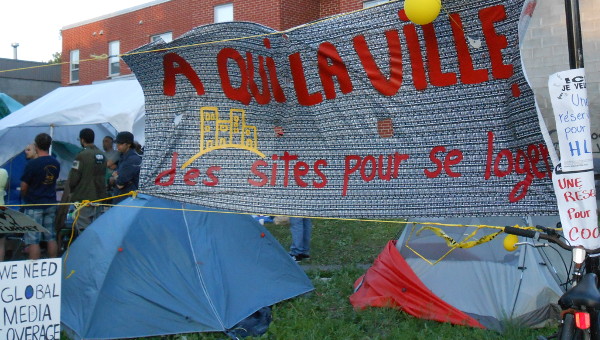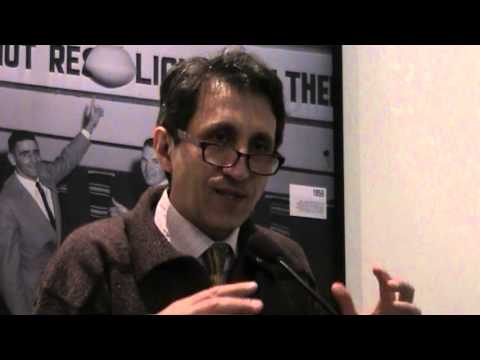Learning from Quebec Students
The 2012 Quebec student strikes delivered one of the few victories we have seen in anti-austerity struggles in the Canadian state. The mobilization, which at its high point saw over 300,000 students on limited or unlimited strike, and demonstrations of hundreds of thousands, was a crucial highpoint that has a great deal to teach radicals. The attempted clampdown by the Jean Charest government through Bill 78 that attempted to outlaw the movement, unleashed a new and innovative round of resistance including the casseroles night marches.

The newly elected Parti Québécois (PQ) government of Premier Pauline Marois immediately cancelled the 75 per cent tuition hike implemented by the previous Charest government and rescinded the oppressive “back to work” legislation in Bill 78. This is a real victory, though the struggle in Quebec must continue. The PQ government has already made cuts to university budgets and is committed to smaller incremental tuition increases, indexing tuition to cost of living increases. Further, the PQ is organizing a series of roundtable discussions on the future of post-secondary education with a very clear agenda for technocratic restructuring that impedes rather than increases democracy, access and quality.
Trying to Spread the Victory
This is a partial victory, but a real one. At a time when the austerity agenda is rolling on relatively unchallenged, the Quebec student strike offers a crucial lesson in resistance. Yet the knock-on effect of that strike has been relatively limited to date. The Quebec student movement has done serious work to reach out to the rest of Canada and elsewhere to share the learning from this incredible mobilization, but at this point the impact has been limited.
This is unfortunate given the desperate need for effective mobilization to halt the austerity agenda in general, and in particular its application to the post-secondary field. The Ontario government is currently implementing a major restructuring of post-secondary education at a quite rapid pace, aiming to shift university mandates toward a market orientation, shift teaching toward on-line courses, continue tuition increases toward the goal of full user-pay, and implement cost-cutting ‘productivity’ increases. It would take a mobilization at the scale of the Quebec student strike to really reverse this agenda, but at this point there are not even many ripples of discontent.
A Mobilizing Perspective
In this article, we will try to discuss some of the ways that we imagine applying lessons from the Quebec student strike in coming battles around education, and particularly post-secondary education. At its core, the Quebec student strike modelled a mobilizing perspective grounded in democracy, militancy and audacity.
Over the last three decades, Quebec’s student movement has been divided between organizations gravitating around two models: a lobbyist model seeking collaboration with governments in place, on the one hand; and a democratic, activist student unionism, on the other. Since the early 1990s, the former model has been adopted by the Fédération étudiante universitaire du Québec (FEUQ) and the Fédération étudiante collégiale du Québec (FECQ), while the latter model has informed the activities of the Association pour une solidarité syndicale étudiante (ASSÉ) du Québec (which regroups 30 local student unions representing some 70,000 CEGEP and university students). We will focus on ASSÉ’s organizing model, which is explicitly ‘unionist’ (syndicale).
The core goal of this unionist model is to defend members’ concrete interests (understood in a non-corporatist way) through their own mobilization. This organizing model is based on democratic decision-making through general assemblies at which a large portion of student body debates action and decides collectively how to proceed. This democracy can only function in a meaningful way when combined with a constant effort at informing and mobilizing the student population beyond layers of activists, in order to develop a membership which can make change with their own hands rather than engaging in periodic ritualistic and symbolic protest. Democracy of this sort is linked to militancy in that the goal of protest is not to appeal to the conscience of those in power, but to build a counter-power in the streets, schools and workplaces that can push back.
In the era of austerity, many unions and social movements have lowered their horizons and tried not to rock the boat too much. For example, Toronto municipal unions met privatization demands with a campaign that focussed more on public relations advertisements than mobilizing their own members, ultimately resulting in concessions. In contrast, the Quebec students mobilized around ASSÉ (who formed the Coalition large de l’ASSÉ (CLASSE) to launch and coordinate the 2012 strike) dared to challenge the core of the government’s post-secondary agenda and boldly campaigned over a two-year period to win a strike mandate.
The challenge to the government’s agenda combined the immediate demand to halt the government’s 75 per cent tuition hike with a broader call to abolish tuition fees and democratize public college and university education. Many students lined up to fight tuition increases, rallying around a demand that seemed winnable (“Stop the hike!”). Yet the mass movement raised many bigger questions about democratic governance and the character of post-secondary education that pointed toward a broader, transformative agenda.
This combination of audacity, democracy and militancy in many ways echoes the crucial battles that won trade union rights for workers in the first place, such as those waged by Windsor auto workers in the 1940s or by postal workers in the 1960s. The challenge outside Quebec is to figure out how to apply these methods in situations where there isn’t the same level of organization and activism or tradition of student mobilization
A Longer-Term Perspective
This was the ninth general strike waged by Quebec students since 1968, and the 11th year since the founding of ASSÉ as a radical and democratic student union consciously committed to learning from that history of struggle. ASSÉ built for the 2012 strike through a two-year campaign, which used petitions, demonstrations and days of action to mobilize students through leaflets, informal networks and structured organization including assemblies.
All of this seems daunting if you are sitting in a place where that long-term work has not been done, and where it is hard to even imagine a way to begin the building process. There is certainly no magic formula, nor any simple overall technique that will automatically elevate campaigns elsewhere. But there is a crucial orientation that others mobilizing against austerity can learn from – that of militant, democratic unionism. The implementation of this orientation requires a longer-term strategy that is difficult to balance with the immediate needs of the anti-austerity struggle.
ASSÉ was founded on the principles of democratic, militant student unionism in 2001. The people who founded the new organization sought to deliberately learn from the prior history of the Quebec student movement, both from the impressive victories and the grinding defeats. Indeed, the need to refound the radical wing of the student movement was an indication of the difficult struggles of the 1990s and the decision to ultimately disband the MDE (the previous radical democratic student union). Before ASSÉ, three student unions based broadly on democracy and militancy (UGEQ, ANEEQ and MDE) had developed and ultimately disbanded since the early 1960s.
At the core of these organizations was the principle of democratic, militant student unionism drawn from the student movement in France and expressed in the Charte de Grenoble from 1946. Article One of this document stipulates: “The student is a young intellectual worker.” Historically, within the Quebec student movement, this has meant that students, like workers, are engaged in collective activities, share common interests and can organize collectively – form unions – to promote these interests. Students have immense potential power through collective organization to withdraw their labour (in strikes) and ultimately take collective and democratic control over the process of education.
The power of student strikes comes from the disruption of an education system that the government as well as campus administrations have a responsibility to administer. For example, university students will have to graduate in order to make room for incoming high school students. Semesters simply cannot be cancelled on a large scale without creating an enormous administrative mess that would also have significant economic consequences. Though governments and administrators will use this cancellation as a threat in effort to force striking students back into class, they are in fact worried by this prospect. This is why semesters have never been cancelled in the history of Quebec student strikes, and why these strikes have forced governments to back down on several occasions.
The best way to make this potential power real is to organize along the lines of democratic, militant unionism, which aims to mobilize the mass of the student body and to win majority mandates for genuine collective action. The general assemblies that are so crucial to the success of the Quebec student movement are grounded in, and indeed cannot function properly outside of, this democratic and activist student unionist perspective. This perspective orients the militant minority toward their fellow students with the goal of discussing and debating in order to win genuine mandates for effective action. This requires constant mobilizing activities, such as printing flyers, publishing newspapers, going from class to class to present updates on campaigns and important issues, and engaging with students in cafeterias and in public spaces. In Quebec, this has generally been organized by mobilization committees in collaboration with student union executive committees.
Trying to adopt the assembly model without this commitment to democratic, militant unionism can lead to the separation of the core activists from most other students. A self-proclaimed assembly of radicals can give themselves a mandate to act in the name of the student body but without the genuine participation of larger layers of students they will remain isolated and they will not be able to build the power necessary to support this mandate. Indeed, one of the problems that lead to the downfall of the earliest Quebec-wide student union (UGEC) was the commitment of radicals to going it alone, without the patience and strategic orientation to win larger mandates.
Democracy and a Mobilized Membership
Democratic, militant unionism means orienting outward to win mandates for mobilization from the student body. Those mandates will only be meaningful if they are won through democratic and participatory forms of organization. The general assemblies of the Quebec student movement have been foundational in winning mandates through forms of decision-making that involve active participation, open exchange and direct democracy. Militant students must engage with those who disagree with them in such assemblies, trying to persuade fellow students that action is possible and necessary. These assemblies can be tense, and the outcome is very hard to predict as people respond to the flow of debate and the exchange of ideas. This puts a real premium on serious preparation to consider in advance the likely flow of debates, the main arguments of critics, and the motions that are likely to be able to sway sufficient support.
“The general assemblies of the Quebec student movement have been foundational in winning mandates through forms of decision-making that involve active participation, open exchange and direct democracy. Militant students must engage with those who disagree with them in such assemblies.”
These assemblies only happen after a great deal of work to mobilize the student body. Indeed, the Quebec student movement’s ability to build on the direct democracy of assemblies should not be romanticized or idealized. To build these democratic structures, and to maintain them over time, requires constant mobilizing efforts. Even if such structures are already embedded in bylaws (which is the case for most Quebec student associations), continuous militant activity remains crucial to breathe life into them. In between periods of mass mobilization (mostly before and during actual strikes), general assemblies tend to be small. Still it is crucial to organize them on a regular basis, as it democratizes and enlarges decision processes beyond executive committees and reminds the broader student population of the existence of the assemblies and their potential collective power. These meetings can become really important formative spaces where new activists have the chance to familiarize themselves with formal assembly rules and with the practice of direct democracy. General assemblies derive from mobilizing practices, but they are also crucial spaces to develop a network of activists that will engage into these practices.
Solidaristic Campus Unionism
Many of us who are active outside Quebec and find this model inspiring face important challenges figuring out where to get stuck in to start building the kind of movement that we have seen in Quebec. The Ontario student movement, for example, has an important and valuable progressive record in many places. Yet it has not been organized on the basis of student unionism that aims to use the strike or occupation as a crucial tool for building student power on campus. There is virtually no prior experience of student strikes in Ontario beyond limited days of action, and even these have seldom ground institutions to a halt.
One of the elements which will be important in building new mobilizing capacities in Ontario and elsewhere will be to develop a militant and democratic unionist orientation among a layer of activists. ASSÉ has quite consciously worked to develop activist capacities among layers of students who operate autonomously but with strong collaboration on different campuses, through activist education and skills-building camps, congresses and ongoing informal discussion and debate. The development of such an orientation will require lots of discussion and debate about such things as developing strategies for relating to student union structures and determining which issues will have traction in the immediate term. We argue that activists seriously oriented to winning democratic mandates from student bodies must seriously engage with existing forms of organization, attempting to transform them into democratic, mobilizing unions if possible. There will, of course, be vibrant debates about this.
One possible way to start would be to build a network of activists oriented toward democratic, activist unionism on the various campuses where they’re based. The network would provide opportunities for shared analysis, evaluation of activities, and joint strategies where feasible. Labor Notes in the United States provides an example: it’s a project whose publications, workshops and conferences link up activists in many unions and workers’ rights groups who share a commitment to democracy, militancy and solidarity. A multi-campus network might provide the opportunity to build a base of activists with shared commitments to militant, democratic campus unionism. •
This article first appeared on the newsocialist.org website.





